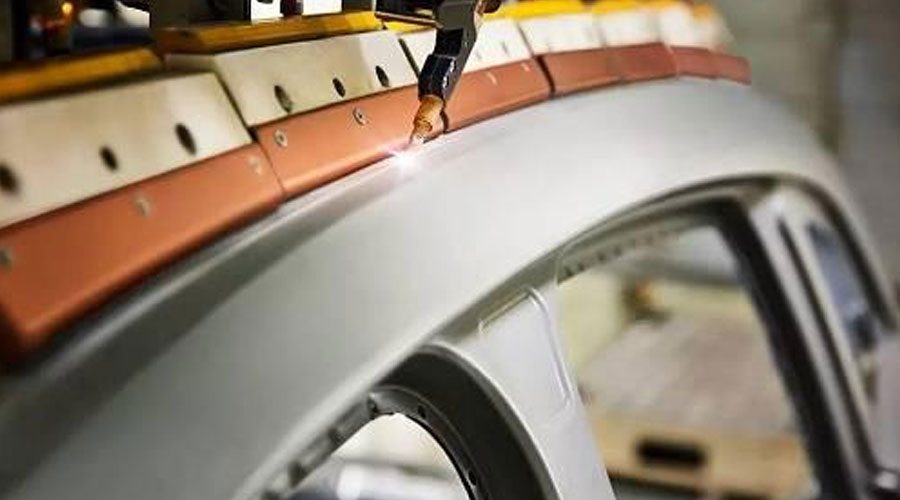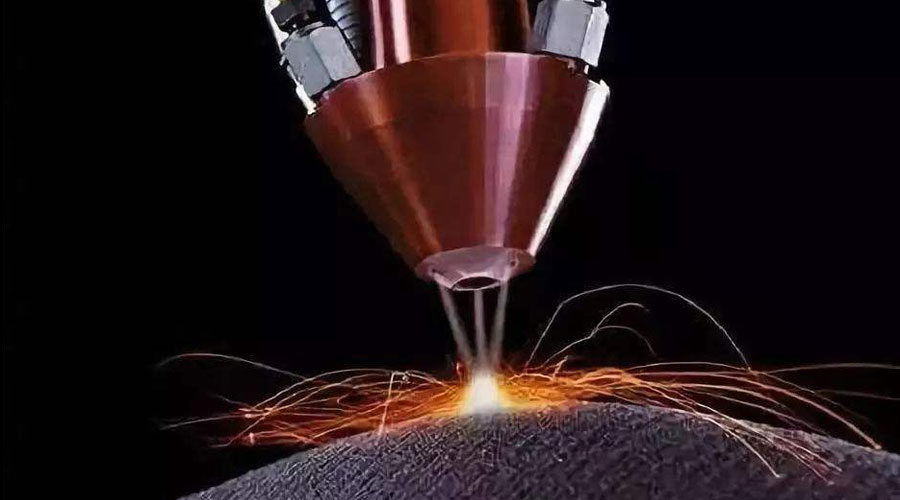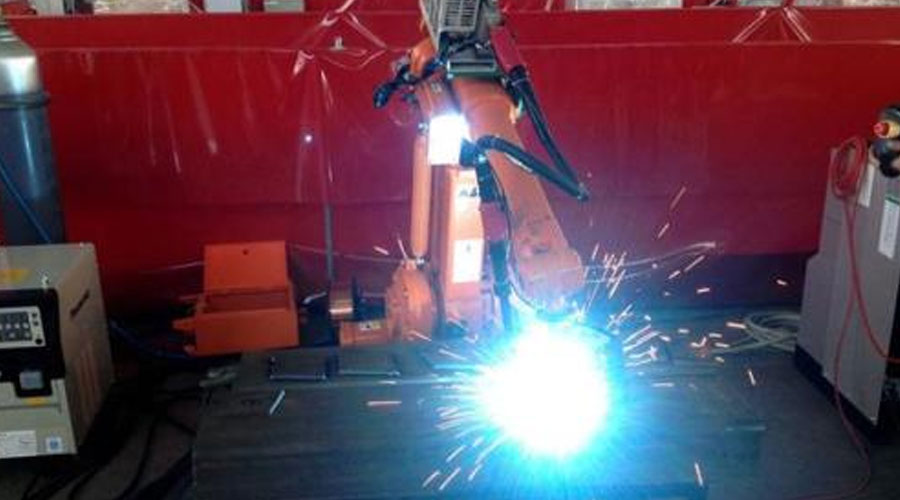Process Analysis In Laser Welding Technology
Process Analysis In Laser Welding Technology

Process parameters of laser welding
1. Power density.
Power density is one of the most critical parameters in laser machining. With a high power density, the surface layer can be heated to the boiling point within a microsecond time range, resulting in a large amount of vaporization. Therefore, high power density is advantageous for material removal processes such as punching, cnc cutting, and engraving. For lower power density, it takes several milliseconds for the surface temperature to reach the boiling point. Before the surface layer is vaporized, the bottom layer reaches the melting point, which is easy to form a good fusion weld. Therefore, in conductive laser welding, the power density is in the range of 104 ~ 106W / cm2.
2. laser pulse waveform.
Laser pulse waveform is an important problem in laser welding, especially for thin-plate welding. When a high-intensity laser beam is irradiated to the surface of the material, 60 ~ 98% of the laser energy is reflected and lost on the metal surface, and the reflectance changes with the surface temperature. During a laser pulse, the reflectivity of the metal varies greatly.
3. Laser pulse width.
Pulse width is one of the important parameters of pulse laser welding. It is not only an important parameter different from material removal and material melting, but also a key parameter that determines the cost and volume of machining equipment.
4.The influence of defocus amount on welding quality
Laser welding usually requires a certain defocus because the power density in the center of the spot at the laser focus is too high and it is easy to evaporate into holes. The power density distribution is relatively uniform across the planes away from the focal point of the laser. There are two ways of defocusing: positive defocus and negative defocus. The focal plane is above the workpiece for positive defocus, otherwise it is negative. According to geometrical optics theory, when the positive and negative separations are equal, the power density on the corresponding planes is approximately the same, but the shape of the molten pool obtained is actually different. With negative defocus, greater penetration can be obtained, which is related to the formation of the molten pool. Experiments show that laser heating of 50 ~ 200us material begins to melt, forming liquid metal and interstitial vaporization, forming market pressure steam, and ejecting at extremely high speed, emitting dazzling white light. At the same time, the high-concentration vapor moves the liquid metal to the edge of the molten pool, forming a depression in the center of the molten pool. When negative defocus, the internal power density of the material is higher than the surface, and it is easy to form stronger melting and vaporization, so that the light energy is transmitted to the material deeper. Therefore, in practical applications, when large penetration depth is required, negative defocus is used; when welding thin materials, positive defocus should be used.

Laser welding process
1.Welding between pieces.
Including butt welding, end welding, center penetration melting welding, center penetration melting welding and other four process methods.
2.Wire and wire welding
Including wire and wire butt welding, cross welding, parallel lap welding, T-type welding and other four process methods.
3.Welding of metal wire and block components.
The laser welding can successfully realize the connection between the metal wire and the block component, and the size of the block component can be arbitrary. Attention should be paid to the geometry of the filamentary element during welding.
4.Welding of different metals
Welding different types of metals should address the range of weldability and parameters. Laser welding between different materials is only possible with certain specific material combinations. Laser brazing Some components are not suitable for laser welding, but laser welding can be used as a heat source to perform soldering and brazing, which also has the advantages of laser welding. There are many methods for soldering. Among them, laser soldering is mainly used for soldering of printed circuit boards, especially for the assembly of chip components.

Compared with other methods, laser soldering has the following advantages:
1.Due to the local heating
the component is not easy to cause thermal damage, and the heat affected area is small, so soldering can be performed near the thermal element.
2.Use non-contact heating to melt the bandwidth without any auxiliary tools
It can be equipped with double-sided components on double-sided printed circuit boards for post-machining.
3.Repeatability is good
The flux has little pollution to the welding tool, and the laser irradiation time and output power are easy to control, and the laser brazing yield is high.
4.The laser beam is easy to achieve beam splitting
Optical elements such as half-lenses, mirrors, prisms, and scanning mirrors can be used for time and space division.
5. Laser brazing usually uses a laser with a wavelength of 1.06um as a heat source
which can be transmitted by optical fiber, so it can be processed in parts that are not easy to weld by conventional methods, and has good flexibility.
6. Good focus
easy to realize the automation of multi-station device.
Laser deep fusion welding
1. Metallurgical process and process theory
The metallurgical physical process of laser deep penetration welding is very similar to that of electron beam welding, that is, the energy conversion mechanism is completed by a "small hole" structure. Under sufficiently high power density light beams, the material evaporates to form small holes. This small hole filled with steam is like a black body, which almost absorbs the energy of the incident light, and the equilibrium temperature in the cavity is about 25,000 degrees. Heat is transferred from the outer wall of the high-temperature cavity, melting the metal surrounding the cavity. The small hole is filled with high-temperature steam generated by continuous evaporation of the wall material under the light beam. The four walls of the small hole surround the molten metal, and the liquid metal surrounds the solid material. The liquid flow outside the pore wall and the surface tension of the wall layer are consistent with the steam pressure continuously generated in the pore cavity and maintain dynamic equilibrium. The light beam continuously enters the small hole, and the material outside the small hole is continuously flowing. As the light beam moves, the small hole is always in a steady state of flow. That is, the small hole and the molten metal surrounding the hole wall move forward with the forward speed of the leading beam, the molten metal fills the gap left after the small hole is removed and condenses with it, and a weld is formed.
2. Influencing factors
Factors that affect laser deep penetration welding include: laser power, laser beam diameter, material absorption rate, welding speed, shielding gas, lens focal length, focal position, laser beam position, laser power at the start and end of the welding. , Descent control.
3. the characteristics of laser deep welding
Features:
-
(1) High aspect ratio. Because the molten metal is formed around the cylindrical high-temperature steam cavity and extends toward the workpiece, the weld seam becomes deep and narrow.
- (2) Minimum heat input. Because the source cavity temperature is high, the melting process occurs extremely quickly, the heat input to the workpiece is extremely low, and the heat distortion and heat affected zone is small.
- (3) High density. Because the small holes filled with high-temperature steam are conducive to the welding pool stirring and gas escape, resulting in the formation of pore-free penetration welding. The high cooling rate after welding makes it easy to miniaturize the weld structure.
- (4) Strengthen the weld.
- (5) Precise control.
-
(6) Non-contact, atmospheric welding process.
4. The advantages of laser deep welding
-
(1) Because the focused laser beam has a much higher power density than conventional methods, resulting in fast welding speed, small heat affected zone and deformation, and can be difficult to weld titanium, quartz material.
- (2) Because the light beam is easy to transmit and control, and does not require frequent replacement of the welding torch and nozzle, significantly reducing the auxiliary time for shutdown, so the load factor and production efficiency are high.
- (3) Due to purification and high cooling speed, the weld is strong and the comprehensive performance is high.
- (4) Due to the low balance heat input and high machining accuracy, remachining costs can be reduced. In addition, laser welding costs are relatively low, which can reduce production costs.
-
(5) It is easy to realize automation, and can effectively control the beam intensity and fine positioning.
5. Laser deep-welding equipment
Continuous-wave CO2 lasers are usually used for laser deep-welding. Such lasers can maintain a sufficiently high output power, produce a "small hole" effect, and penetrate through the entire workpiece cross-section to form a strong welded joint. As far as the laser is concerned, it is just a device that can generate a parallel beam with good directivity that can be used as a heat source. If it is guided and shot to the workpiece after effective machining, its input power has strong compatibility, making it better suited to automated processes. In order to effectively perform welding, the laser and other necessary optical, mechanical and control components together form a large welding system. This system includes lasers, beam transmission components, workpiece handling and moving devices, and control devices. This system can be simple manual handling and fixing of the workpiece by the operator, or it can include automatic loading, unloading, fixing, welding, and inspection of the workpiece. The overall requirement for the design and implementation of this system is to obtain satisfactory welding quality and high production efficiency.
5. Laser welding of steel materials
- laser welding of carbon steel and ordinary alloy steel. In general, laser welding of carbon steel works well, and its welding quality depends on the impurity content. Like other welding processes, sulfur and phosphorus are sensitive factors that cause welding cracks. In order to obtain satisfactory welding quality, preheating is required when the carbon content exceeds 0.25%. When steels with different carbon contents are welded to each other, the welding torch can be slightly biased to the side of the low carbon material to ensure the quality of the joint. Low carbon boiling steel is not suitable for laser welding due to high sulfur and phosphorus content. Low carbon killed steel has good welding effect due to low impurity content. Medium and high carbon steels and ordinary alloy steels can be laser welded well, but preheating and post-weld machining are required to eliminate stress and avoid crack formation.
- Laser welding of stainless steel. In general, stainless steel laser welding is easier to obtain quality joints than conventional welding. Due to the small heat-affected zone at high welding speeds, sensitization is not an important issue. Compared with carbon steel, stainless steel's low thermal conductivity makes it easier to obtain deep penetration narrow welds.
- Laser welding between different metals. The extremely high cooling speed and small heat affected zone of laser welding create favorable conditions for the compatibility of materials with different structures after melting of many different metals. It has been proven that the following metals can be successfully laser deep-welded: stainless steel ~ low carbon steel, 416 stainless steel ~ 310 stainless steel, 347 stainless steel ~ HASTALLY nickel alloy, nickel electrode ~ cold forged steel, bimetal strips with different nickel content.
|
PTJ Machining Capabilities |
|
Automatic Bar Machining – Multi-spindle cam automatic screw machines CNC Turning – CNC delivers peak cost efficiency in shorter volumes, as well as high capacity production of mechanically simple components Custom Machining - with up to 12 axes of control Multi Spindle Machining- ISO 9001:2015 certified Screw Machine Products – The number of customized production parts per hour can reach 10000pcs Swiss Machining – with up to 9 axes of CNC control, to produce precision components with complex geometries in one operation High Volume Machining – 100 Advanced Production Turning Bar Automatics On-line and Ready CNC Milling - Machining Fully compliant with the exacting requirements of our customers 5 axis (11 axis) Machining – Tolerance | 0.1mm alignment |
What Can we help you do next?
∇ Get more information about cnc machining Shop
→Case study-Find out what we have done.
→Ralated tips about cnc machining services
By PTJ Manufacturing Shop|Categories: Blog|Tags: cnc milling services, cnc turning services, milling parts, turning parts, machining parts, special parts,faqs,technical news,company news,material news |Comments Off
